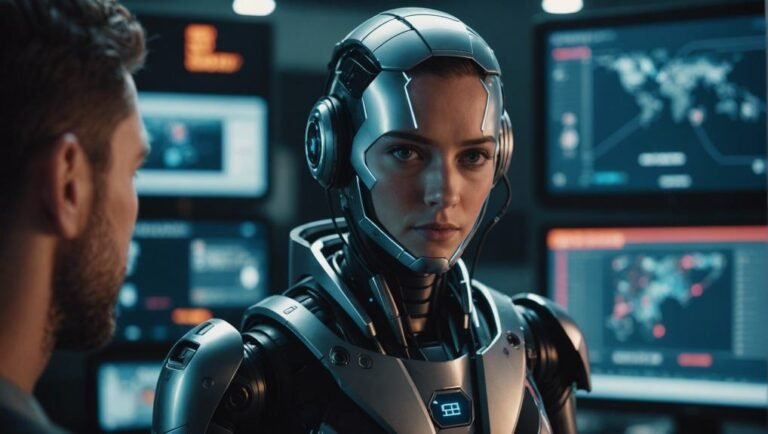What Is Open Artificial Intelligence? A Quick Guide.
Imagine going to a big tech summit in Silicon Valley. You hear some of the smartest people in the world talking. They talk about using open-source projects for healthcare with artificial intelligence. They use Python, R, and C++ to make a model that can find cancer early. This was usually done by doctors with many years of training.
They then talk about big leaps in deep learning models. Companies like Alphabet, Apple, Microsoft, and Meta are using AI. They use it to make customer service better and to help in science. “Open artificial intelligence” is more than just a trend; it’s a big change for the better. With open AI, more people can join in, from small researchers to big companies. This gives more power for everyone to improve together.
Key Takeaways
- Open AI promotes transparency and collaboration in the field of artificial intelligence.
- Popular languages for AI development include Python, R, Java, C++, and Julia.
- Companies like Alphabet, Apple, Microsoft, and Meta lead the use of AI for innovative solutions.
- Open AI systems can help detect early-stage diseases and streamline various industry processes.
- The cost of training advanced models like GPT-4 highlights the investment involved in AI development.
Understanding Open Artificial Intelligence
Open artificial intelligence is becoming very important in the AI world. It’s key in making advanced technology. In this part, we will look at what open AI is. We’ll see why it matters in our tech-filled world today.
Definition of Open AI
Artificial intelligence means machines do things that need human intelligence. Open AI is about sharing and developing AI tech openly. This way, more people can take part and make AI better. This makes open ai software reach more users.
Historical Context
Open AI has a history along with artificial intelligence. AI started in the 1950s with John McCarthy at Dartmouth College. In 2015, OpenAI began with support from Elon Musk and Sam Altman. It had a big start with $1 billion to fund its work. By 2018, it was helping both nonprofits and for-profits with its AI knowledge. Innovations like Dall-E and ChatGPT have made OpenAI a key player in AI.
Importance in Modern Technology
Today, AI is in many parts of our daily lives. Open source ai helps make things like search engines and self-driving cars better. It also helps companies with jobs like spotting fraud and helping customers. With the new ChatGPT Enterprise, open AI keeps getting better. It shows AI is a big part of making our future technology and industry changes.
How Does Open AI Differ from Traditional AI?
Modern tech talks a lot about the differences between open AI and traditional AI. OpenAI’s GPT-4, for example, creates new content. It does this by learning from the content it was trained on. On the other hand, traditional AI looks at current data. It then makes smart guesses or decisions based on that data.
Core Principles
Core principles of open AI focus on being open, clear, and getting help from the community. OpenaiDonakosy, for instance, shares its code, algorithms, and data. This sharing helps new ideas grow and connects people to work together. This is very different from systems that keep things secret and try to control all the information. Those systems often miss out on great ideas from the wider community.
Accessibility and Community Collaboration
An important thing about open AI is that it’s easy to use. It welcomes everyone to join in, from experts to fans. People work together in these open places to make AI do more interesting things.
By being open, everyone around the world can share their knowledge. This sharing of ideas makes the AI field move ahead faster. This way of working together really makes open AI stand out from older, secretive ways of doing AI.
| Feature | Open AI | Traditional AI |
|---|---|---|
| Main Focus | Inclusivity, Transparency, Collaboration | Control, Security, Predictive Analysis |
| Key Use Cases | Community Contributions, Rapid Prototyping | Chatbots, Predictive Analytics, Recommendation Systems |
| Notable Example | OpenaiDonakosy, GPT-4 | Many Proprietary Systems |
| Strengths | Innovation, Community Input | Control, Quality, Security |
The Role of Open Source in AI Development
Open source AI is making a big difference in the AI world. It helps bring people together to make new things and save money. Any developer from any place can join in, make changes, and help grow AI tech. This creates a welcoming space for everyone to work together.
Benefits of Open Source AI
Open source AI speeds up how fast we make new things. People all over the world share what they know. This way, new tech isn’t just for a few big companies. Plus, people can spend less money when they share their software. Companies have saved nearly $9 trillion because of this. It also helps make strong communities around products, like Google’s Android did.
Popular Open Source AI Platforms
Some tools stand out for making cool AI apps. TensorFlow and PyTorch are famous for their big libraries and helpful people, making tough jobs in AI easier. JAX brings something special too, with its fast math tricks. All these tools give AI developers many choices.
Examples of Open AI Projects
Many open AI projects show how powerful open source is. AlphaFold by DeepMind changed how we look at proteins, solving a hard science problem. Other projects use AI to watch over our planet, keeping nature safe. This shows AI can do lots of different good things.
Big companies and groups like Meta and Red Hat are moving open-source AI forward. They’re making new ways for everyone to share and work together, making AI development fairer and more open. This is shaping the future of how AI gets made.
Key Technologies in Open AI
Open AI includes cool tech like machine learning, NLP, and deep learning. They help AI get smarter, understand us better, and handle tough data.
Machine Learning
Machine learning is key in open AI. It lets machines learn and decide using data. For example, GPT models by OpenAI are famous. They use machine learning. This tech has three main types: supervised, unsupervised, and reinforcement learning. Each type helps with different tasks in dealing with big data.
Natural Language Processing
NLP is super important for machines to talk and understand our language. OpenAI made big steps in this with ChatGPT and OpenAI API. These help make talking to computers easier. It boosts what we can do and helps us work more smoothly.
Deep Learning
Deep learning is powered by artificial neural networks. It’s key for improving AI. Thanks to it, AI is getting better at spotting images and understanding speech. OpenAI’s DALL-E and CLIP are good examples. They use deep learning to make interesting content and analyze hard visual info.
| Technology | Function | OpenAI Implementations |
|---|---|---|
| Machine Learning | Enables machines to learn from data and make decisions | GPT Series, GPT-3, Codex |
| Natural Language Processing | Allows machines to interpret and generate human language | ChatGPT, OpenAI API |
| Deep Learning | Utilizes neural networks for complex data analysis | DALL-E, CLIP, Whisper |
OpenAI keeps making new things. Mixing machine learning, NLP, and deep learning leads to more progress. And it all keeps being useful and safe for us.
What is Open Artificial Intelligence?
Open Artificial Intelligence is about making AI for everyone to use. It focuses on sharing and being clear about how AI works. Everyone can join in to make AI better, not just a few companies. This way, the AI world is friendly and open to all, leading to new and better things.
This AI world gets stronger when people work together. In 2023, a big report showed that most of the AI code checked was open for all to see. This shows how much we all work together to push AI forward. Many smart people are helping, making big steps in AI.
One big step is Meta’s Llama 2, with lots of ready-to-use models. Mistral AI made a very big model called Mistral 7B. And they even beat some big players with Mixtral 8x7B. This one is special because anyone can use it. Mistral made it open for all to enjoy.
The open AI family sees cool things every day. Like when Databricks got MosaicML. It brought MPT-7B and MPT-30B to the community. BigScience shared Bloom, made by lots of people, and Technology Innovation Institute made Falcon LLM. These are big wins for open AI.
Many famous open AI models show how far we’ve come. Here are some names:
- Meta’s Llama 2
- Mistral AI’s Mistral 7B and Mixtral 8x7B
- BigScience’s Bloom
- The Falcon LLM
- Google’s FLAN-T5
- GitHub and Hugging Face’s StarCoder
- Together AI’s RedPajama-INCITE-3B
- Cerebras’ Cerebras-GPT
All these models help make AI better, safer, and cheaper. Big companies like Google and OpenAI are also jumping in. So, open AI is getting bigger and better. We’re talking more about good use and how to be fair with AI. This way, open AI stays by everyone, for everyone, making great things happen.
Popular Open AI Tools and Platforms
Many companies have started using open source AI tech. 48% use it now, and it will hit 65% soon. The well-liked tools include TensorFlow, PyTorch, and JAX. They help both developers and businesses in unique ways.
TensorFlow
Google made TensorFlow to fit many needs with its flexible graph. It has lots of info, like videos, and works with different languages. This makes it great for many AI projects.
PyTorch
PyTorch is from Facebook’s lab and is known for trying new things easily. It’s simple and clear to use, which developers love. Working together with others helps it improve all the time.
JAX
JAX is focused on quick, efficient machine learning research. It uses special math tools to do things faster. This makes it interesting for those who want the latest in AI.
| Feature | TensorFlow | PyTorch | JAX |
|---|---|---|---|
| Developed By | Facebook AI Research | ||
| Key Strength | Flexible computational graph | Dynamic computation graphs | Automatic differentiation |
| Popular Use Case | Diverse architectures | Rapid experimentation | High-performance ML research |
More and more, open AI tools are coming out. With TensorFlow, PyTorch, and JAX, developers have tons of options. These tools push for new and better tech in our ever-growing digital world.
Applications of Open AI
OpenAI is changing many fields with new AI like better health care and finance forecasts. Its impacts on technology today are huge.
Healthcare
In health care, OpenAI is making big differences. It’s helping doctors diagnose diseases more accurately. It also helps create treatment plans just right for each patient. This means fewer mistakes and more effective treatments, especially for finding cancer early.
Finance
AI in finance is changing how banks and other money companies work. It helps with predicting what will happen and with analyzing risks. This can help these companies make smarter choices to make more money. For example, AI can look at the stock market and suggest the best moves for investments.
Manufacturing
AI in making things has made big improvements in production and upkeep. It helps factories work better, have less time when they’re not working, and know when machines need fixing. These changes help make making things more efficient and cheaper, saving both resources and money.
Entertainment
The way we enjoy shows and games is getting better thanks to AI. OpenAI powers features like better video streaming picks and making cool media. Its technologies add more personalized and enjoyable content for everyone.
OpenAI is making big marks in many areas, from health to how we have fun. Its effects show how powerful and useful AI can be. It’s changing the game in many industries.
| Industry | Key Benefits |
|---|---|
| Healthcare | Improved diagnosis accuracy, personalized treatment plans |
| Finance | Predictive modeling, enhanced decision-making |
| Manufacturing | Optimized production, maintenance prediction |
| Entertainment | Personalized content, engaging user experiences |
Benefits of Open AI for Businesses
Open AI offers big benefits for companies wanting to do better. It helps with being more efficient, coming up with new things, and giving customers great service. Using AI can help businesses save money and be more competitive.
Cost Efficiency
The AI solutions from OpenAI are cost-effective. They can cut down on the money spent for handling data and buying special software. For example, adding natural language models and machine learning to apps makes things smoother. This lessens the need for lots of coding. Automating jobs such as looking at data and helping customers cuts down on work needed.
Innovation and Customization
To keep up these days, being innovative is crucial. OpenAI’s close work with top tech companies, like Microsoft, brings quick progress in AI tools. This supports a lot of new ideas, letting companies build special AI tools that fit their needs. Knowing what people want and making things just for them really boosts how well a business runs.
- OpenAI researchers are always breaking new ground in areas like NLP, robotics, and more.
- Being scalable helps companies work with large amounts of data easily.
- Using predictive tools helps in better figuring out sales and what customers might do.
Here’s a detailed look at what businesses gain from using OpenAI:
| Benefit | Description |
|---|---|
| Cost Savings | Less work means less money spent on labor. |
| Enhanced Security | Better data protection and making sure who’s using the app improves security. |
| User Engagement | Enhancing what the app does makes users want to use it more. |
| Scalability | You can handle a lot of data and requests with ease. |
| Innovation | It drives the creation of cool new app features. |
In the end, Open AI’s benefits include saving money and being innovative. They are really important for businesses today. Using OpenAI means things run better and that you can offer customers more special, better service.
Challenges and Considerations in Open AI
Using open AI comes with big challenges. You have to think about data privacy, avoid bias and think ethically, and deal with tough technical issues.
Data Privacy
Keeping data private is a tough challenge in open AI. AI needs a lot of data. This makes people worry about how it’s used and protected. OpenAI works hard to keep your info safe and follow the law.
Bias and Ethics
AI must be fair and right. But sometimes, it learns wrong things from bad data. Then it can make unfair choices. OpenAI fights this by trying to be fair, clear, and listening to everyone’s ideas.
Technical Complexity
Making AI work is not easy. It needs smart people and a lot of learning. OpenAI is always getting better and working with experts. This helps make AI that’s smarter and safer.
| Challenge | Description | Efforts by OpenAI |
|---|---|---|
| Data Privacy | Concerns about data collection, storage, and security | Rigorous data governance practices |
| Bias and Ethics | Potential for discriminatory behavior due to biased training data | Initiatives to mitigate biases and ensure transparency |
| Technical Complexity | Advanced skills and understanding required for AI development | Collaboration with the research community and continuous innovation |
The Future of Open AI
The future of Open AI is bright. It will change how we use technology. The AI market will be worth $135.83 billion by 2022. This shows the big interest in AI.
Emerging Trends
Many trends show where Open AI is heading. Generative AI tools like ChatGPT are getting popular. They could help OpenAI make $1 billion a year. Big companies like Microsoft are also investing a lot, $10 billion this year alone.
Companies like Nvidia and Salesforce want to work with OpenAI too. They want to use their tech to grow. OpenAI is also working on big projects like neuroevolution. This shows how fast AI is growing.
Predicted Impact on Industries
Open AI will change many industries. In healthcare, it will make diagnosing people better and help with research. In finance, it will make decisions quicker and spot fraud easily. The manufacturing field will see better-quality products from using Open AI.
And, everyone is excited about self-driving cars from Open AI. They could make roads safer. Open AI is now worth over $80 billion. Its leaders, like Elon Musk, are starting something big.
| Sector | Open AI Impact |
|---|---|
| Healthcare | Improves diagnostic accuracy and speeds up research |
| Finance | Enhances data-driven decision-making and fraud detection |
| Manufacturing | Optimizes production lines and quality control |
| Transportation | Pioneers autonomous vehicle technology to reduce accidents |
Looking ahead, Open AI offers many chances and hurdles. It raises questions about ethics and jobs. The AI impact is big, changing both old and new fields. Great leaders and constant new ideas make this happen.
Conclusion
Open Artificial Intelligence is changing how we think about AI. It lets more people work together on AI projects openly. This change brings new chances for everyone and helps in many fields.
AI can make our work smarter and more creative. But, we must be careful. If not used right, AI can cause problems. It may use old information that is unfair or wrong. Governments need to watch over AI use. It’s needed to keep AI from doing harm.
Teaching about AI early is very important. Kids should learn about AI from the start. This helps them use AI well. Also, it’s key that those studying AI share what they find. This includes the good and the bad about AI. Working together, humans and AI can do great things. This teamwork makes our society better. There are lots of new things AI can do for us. We’re just starting to explore this exciting area.
Source Links
- What is artificial intelligence (AI)? Everything you need to know
- Everything You Ever Wanted to Know About Artificial Intelligence
- What Is Artificial Intelligence (AI)?
- What is OpenAI? Definition and History from TechTarget
- OpenAI
- What is (AI) Artificial Intelligence? | Online Master of Engineering
- The Difference Between Generative AI And Traditional AI: An Easy Explanation For Anyone
- Open vs. Closed AI: What’s the difference and which suits your business the most? ?
- OpenAI vs. Traditional AI: Understanding the Difference
- The tech industry can’t agree on what open-source AI means. That’s a problem.
- Bringing the open source way to AI
- How restrictions on open-source development of AI can hurt the tech industry and us #wef24
- What Is OpenAI? Learn About Its Mission, Products, and Key Advancements
- Social Media Reporting – Keyhole
- Why protecting an open AI ecosystem should be a cornerstone of technology regulation
- Council Post: The Rise Of Open Artificial Intelligence: Open-Source Best Practices
- What is Artificial Intelligence (AI)? | IBM
- Inside OpenAI, Elon Musk’s Wild Plan to Set Artificial Intelligence Free
- Top 10 Open Source Artificial Intelligence Software in 2021 – Spiceworks
- 10 open source AI platforms for innovation | DigitalOcean
- 10 Top Open Source AI Platforms and Tools to Try Today
- 4 Real-world Examples of Using OpenAI in Development
- Applications of OpenAI in Business and Industry
- 4 Open AI Tools Used in Mobile Apps Development
- The Pros And Cons Of Using OpenAI In Mobile App Development
- Leveraging OpenAI in Business: Benefits & Uses
- What Is OpenAI? Everything You Need to Know
- Exploring the Ethical Implications of OpenAI – 3Cloud
- Introducing a Groundbreaking AI Concept to the OpenAI Community
- OpenAI Faces Growing Challenges Amidst Success
- Everything You Need to Know About the Future of OpenAI
- Explore the Future with Open AI: Your Guide to Artificial Intelligence
- What’s next for OpenAI
- Conclusions
- Comparing Generative AI and Open AI in Digital Marketing: Harnessing the Power of Artificial Intelligence
- Unpacking the hype around OpenAI’s rumored new Q* model







